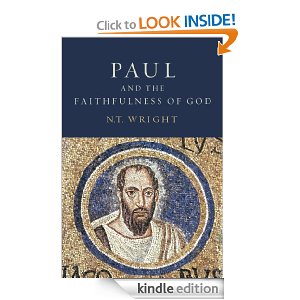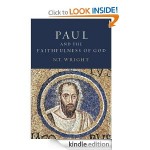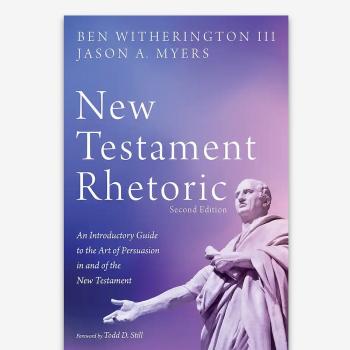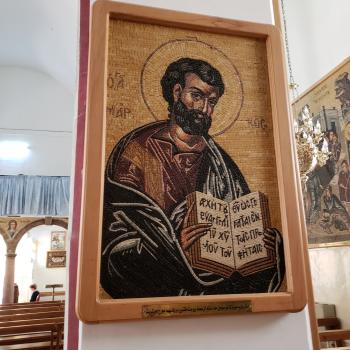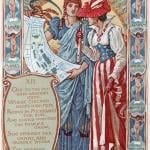As Tom begins his discussion of election, he freely admits that his view stands more on the salvation history side than on the apocalyptic side when it comes to analyzing how Paul tells the story. Tom is prepared to talk about the fulfillment of the story of Abraham, and indeed of the Abrahamic covenant. He is even prepared to talk about the choosing of Abraham having to do with the undoing of the sin of Adam and its effects, the Fall. On p. 784 he says— “As far as Paul was concerned, the reason the creator God called Abraham in the first place was to undo the sin of Adam and its effects. Paul’s basic contention, in the area of election, was that, through the Messiah and the spirit, this God had done what he promised Abraham he would do.”
To demonstrate this thesis, Tom first sets out the parallels between the mandate to Adam (‘be fruitful and multiply’) and the promises to Abraham. ‘I shall multiply your kindred’, to Isaac, to Jacob, and beyond. The problem is there is a fundamental difference here and two points can be made: 1) with Adam, Adam is commanded to be fruitful and multiply. With Abraham, Isaac, and Jacob God promises that HE will multiply their kindred. There is a difference. 2) if ‘be fruitful and multiply’ does not imply a mission to save the world by pre-Fallen Adam, it is hard to see how the promise that God will bless the patriarchs with offspring unto many generations implies such a mission. Making babies is one thing, saving a fallen world another, and the command to Adam at least can’t have anything to do with saving the world. It didn’t need saving yet. Now Tom recognizes the shift— having children becomes a gift from God, a blessing. Yet it is hard to see the justification for talking about the recapitulation of the Adamic blessing. A mandate is not a blessing, so let the two stories be different in this case, hence, no recapitulation per se.
There is more however to be said for this parallel– Adam is given the garden, sins, and is exiled from it. Abraham and his descendants are given the promised land, sin, and are exiled from it. p. 787 brings out another interesting parallel– Noah, a new Adam, presides over a restored world after the flood, a renewal of creation after the images from Gen. 1.26ff. Following Michael Fishbane, Tom notes that the three blessing promise to Abraham–a promised land (reversing the curse on the earth), promised progeny (reversing the problems and pain and danger in child-bearing), and fruitful labor (reversing the curse of futile and difficult labor). There were 10 generations from Adam to Noah, and another 10 from Noah to Abraham, and apparently these stories are carefully plotted and linked, and bear resemblances to one another. But in what sense is this story a story of redemption in a later Christian sense, if at all?
Tom suggests (p. 788) “God acts to undo the fateful sin in the garden, and he does so not least through the offering of Abraham’s beloved son, Isaac.” The words of the angel to Abraham suggest that just the willingness to offer his son has broken a barrier and and now blessing can flow not just to Abraham but to the wider world. The problem with this is, without the shedding of blood there is no atonement for sin, and as marvelous as the Aqedah story is, it does not provide a basis for the redemption of the world. It simply doesn’t. The blessing of the world, yes perhaps. Its redemption no.
It is also true that we have in the case of the Abraham story various precursors to the later Mosaic stories— Abraham and Sarah go to Egypt due to famine, there are plagues which free them from entangling alliances with Pharaoh. Tom on p.791 also points out how the Aqedah is paralleled with the story of the death of the first born of Pharaoh, and the passing over of the first born of Israel. The blood of the lamb was to be the sign by which redemption was to be wrought. It is one thing however to talk about types and antetypes, another thing to talk about installments of redemption along the way. Strictly speaking the lamb’s blood simply spares the Israelites from the judgment on the first born. Pharaoh still has to let them leave the land. The passover event involves the an atropaic sacrifice– not one that atones but one that averts disaster. The lamb is not the redeemer, the lamb’s blood simply prevents something terrible from happening. I point this out because a precursor is not an installment. At some juncture the discontinuity with the new covenant and the work of Christ needs to be made clear. A near human sacrifice in the story of Abraham is not a true first installment of true or full redemption any more than the smeared lambs blood is in Egypt. A foreshadowing is not the same as a foretaste.
In regard to circumcision and the Abrahamic covenant as opposed to the Mosaic covenant, there is a signal difference here as well. In the case of Abraham the covenant is made on the basis of Abraham trusting God and it being credited to him as righteousness. The covenant has already been made when he gets the sign in Gen. 15, and so the sign becomes just a confirmation of a reality that already exists. In the case of the Mosaic covenant, the covenant is cut, inaugurated by the act of circumcision itself. Paul himself will go on to dwell on the differences between these two covenants in various ways— for one thing one is fulfilled, the other annulled. One is linked to an everlasting covenant. The other is pro tempore. And here it seems that a purely salvation historical reading of the Bible, that suggests an ongoing continuous story flowing on like a mighty river, in the end doesn’t entirely work. After all, it is the periodic mighty acts of God that bring about redemption. It does not happen as a normal historical process. Thus while there is something to be said for the salvation historical reading of Paul’s reading of the OT, there is also something to be said for the apocalyptic reading as well. One has to do justice to both elements. And then of course there is a more salient difference than even those just mentioned— the giving of Torah to Moses. This especially makes clear the difference with the essence and the basis of the Abrahamic covenant. Faith is the basis or very essence of the former covenant, ‘works of the law’ of the latter.


